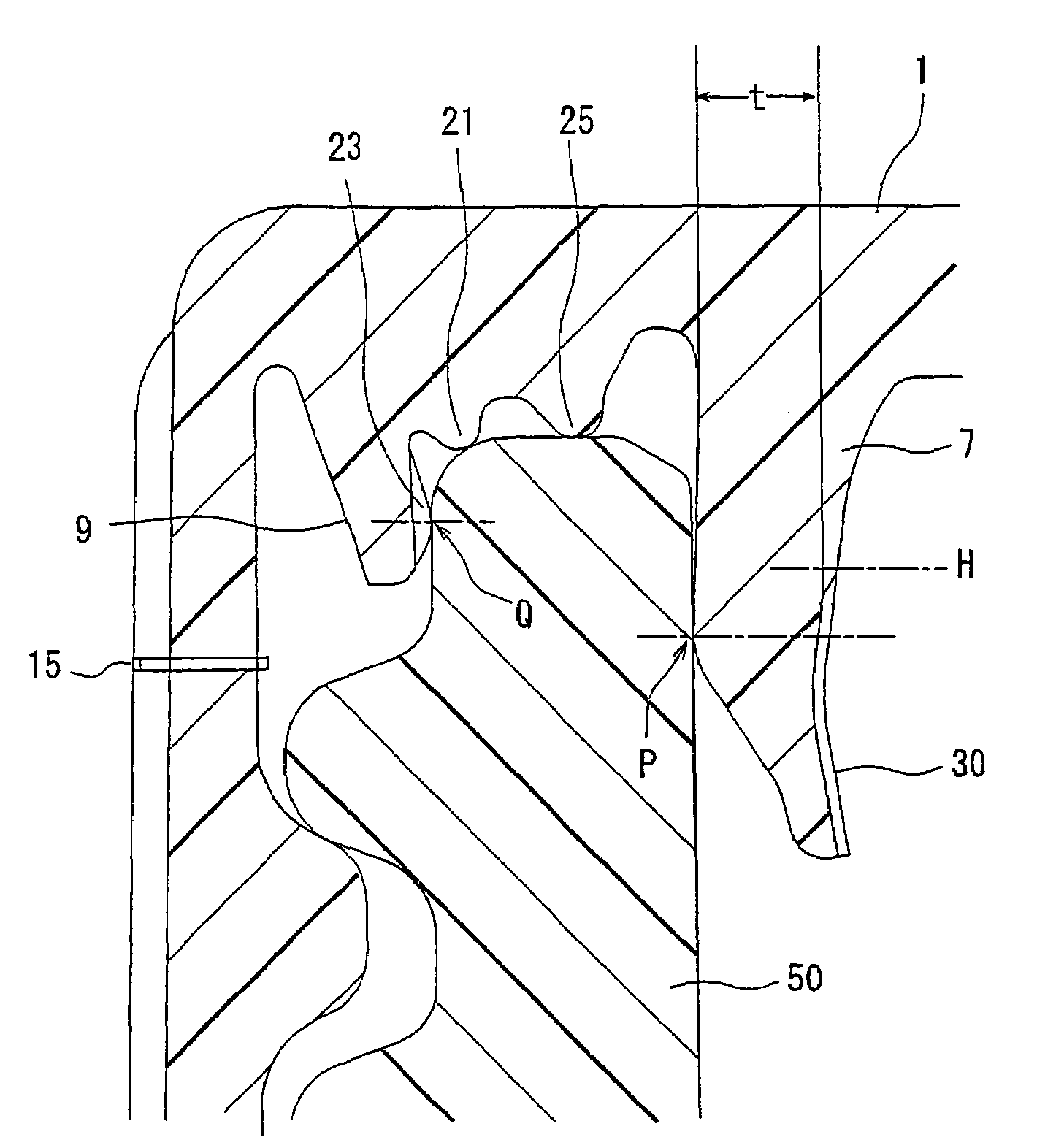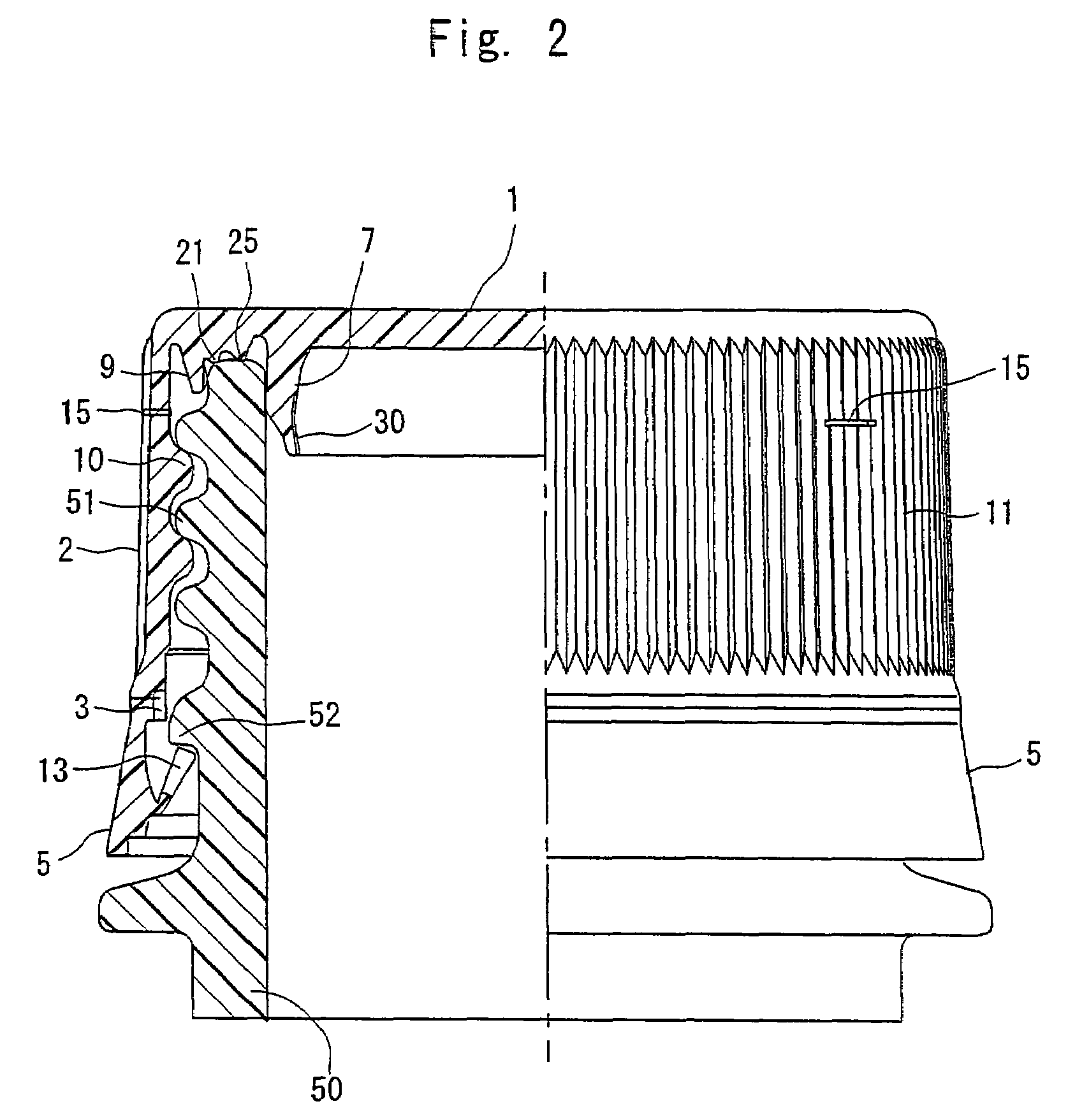Plastic cap featuring excellent sealing and venting
a technology of plastic caps and sealing rings, applied in the field of plastic caps, can solve the problems of difficult gas venting, easy deformation of inner rings, and decreased thickness of inner rings, and achieve the effect of convenient venting
- Summary
- Abstract
- Description
- Claims
- Application Information
AI Technical Summary
Benefits of technology
Problems solved by technology
Method used
Image
Examples
examples
[0055]Effects of the invention will now be described by way of the following Experiments. Here, however, the invention is in no way limited to the Experiments only.
Cap A (Present Invention):
[0056]There was formed by compression molding a cap having the same shape as that of FIG. 1 and that could be wrapped and tightened to the mouth of the container of a nominal diameter of 28 mm.
[0057]One recessed portion 30 (width w of 3 mm) was formed. The distance between the upper end position H of the recessed portion 30 and the seal point P was 0.4 mm. The root portion of the inner ring 7 forming the recessed portion 30 therein possessed a thickness of 1.1 mm, and the recessed portion 30 possessed a depth of 0.1 mm.
Cap B (Present Invention):
[0058]A cap B was formed in quite the same manner as the cap A but forming six recessed portions 30 in the inner surface of the inner ring 7 maintaining an equal distance, each recessed portion 30 having a width w of 1 mm, a depth of 0.15 mm and running ov...
experiment 1 (
Drop Impact Test):
[0060]500-Milliliter PET bottles were filled with a 1% orthotolidine aqueous solution heated at 87° C., wrap-tightened with caps A to C, cooled with the shower, and preserved at normal temperature for 24 hours to prepare test samples on which the caps A to C were wrap-tightened, each in a number of 10.
[0061]Hypochlorous acid was dropped on the caps of the test samples each of a number of 10 prepared above. The test samples in an inverted state were dropped in a vertical direction on a steel cylindrical member of which the upper surface had been inclined at 10° from a height of 100 cm. Thereafter, the test samples were immersed in the hypochlorous acid diluted with the tap water of 5° C. for 24 hours.
[0062]There was recognized no change in the color of the 1% orthotolidine aqueous solution in the bottles of the test samples each of a number of 10 to which the caps A and B of the invention and the caps C of Comparative Example had been wrap-tightened. That is, the se...
experiment 2 (
Vent Test):
[0063]500-Milliliter PET bottles were filled with the tap water heated at 87° C., wrap-tightened with caps A to C, cooled with the shower, and preserved at normal temperature for 24 hours to prepare test samples on which the caps A to C were wrap-tightened, each in a number of 10.
[0064]The test samples each of a number of 10 prepared above were held in a water vessel, and a needle having a nitrogen injection hole was stubbed into the top panels of the caps. Nitrogen was injected through the injection hole at a rate of 0.034 MPa / sec to measure the pressure in the bottle at which the seal between the bottle and the cap was broken and nitrogen leaked out. Here, however, the measurement was taken in a state where the test samples were held in a casing such that the bottles were not broken by the pressure of the gas.
[0065]In the test samples of the number of 10 wrap-tightened with the cap A of the invention, nitrogen leaked at an average pressure of 0.78 MPa and the gas could ...
PUM
| Property | Measurement | Unit |
|---|---|---|
| width | aaaaa | aaaaa |
| thickness | aaaaa | aaaaa |
| depth | aaaaa | aaaaa |
Abstract
Description
Claims
Application Information
 Login to View More
Login to View More - R&D
- Intellectual Property
- Life Sciences
- Materials
- Tech Scout
- Unparalleled Data Quality
- Higher Quality Content
- 60% Fewer Hallucinations
Browse by: Latest US Patents, China's latest patents, Technical Efficacy Thesaurus, Application Domain, Technology Topic, Popular Technical Reports.
© 2025 PatSnap. All rights reserved.Legal|Privacy policy|Modern Slavery Act Transparency Statement|Sitemap|About US| Contact US: help@patsnap.com



